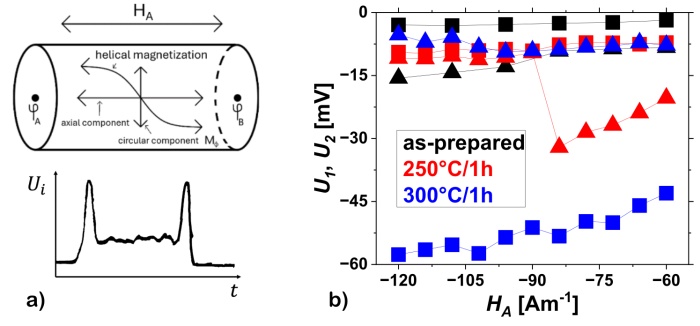Speaker
Description
Amorphous glass-coated microwires are composite materials that consist of metallic core covered by a glass coating. It has been shown that the domain wall propagation in microwires is accompanied by induction of electric voltage at the ends of the wire [1] (Fig. 1a). It arises from a small circular component of the magnetization (Fig. 1a) that is introduced to microwires during their manufacturing process. Even though several studies [2] have been devoted to the origin of the induced voltage, it is still not clear how the voltage can be increased by tailoring of magnetic anisotropies.

Fig. 1 a) Induced voltage is generated at the ends of the wire when the circular component of the magnetization changes. b) Dependence of $U_1$ and $U_2$ (voltage induced during DW depinnig - square symbols, and pinning - triangular symbols) on the magnitude of the axial magnetic field at different torsional annealing temperatures.
In this paper, we performed several thermal treatments of microwires aiming at very high electrical voltage in microwires. In the first part of the experiment, the effect of a transverse magnetic field on the dynamics of the domain walls is analyzed. The transverse field has the most pronounced effect on the voltage induced by the domain wall pinning at the end of the microwire. Torsional annealing of microwires significantly increases the induced voltage at the ends of the microwire, with higher annealing temperatures causing a larger increase (Fig. 1b). Stress-annealing does not increase the voltage caused by the depinning and pinning of the domain wall at the ends of the microwire but increases it during its propagation. Measurements of hysteresis loops at multiple points along the microwire show that the domain structure varies along the microwire. The closure domain structure at the ends of the microwire results in a distinct difference in the shape of the loops compared to the rest of the microwire. This work contributes to a better understanding of the phenomena in microwires and to the optimization of their use in real-world applications.
Acknowledgements
This work was supported by the Slovak Research and Development Agency under contract No. APVV-SK-FR-22-0016.
References
[1] A. F. Cobero et al., “Matteucci effect in glass coated microwires,” IEEE Transactions on Magnetics, vol. 35, no. 5. Institute of Electrical and Electronics Engineers (IEEE), pp. 3382–3384, 1999. doi: 10.1109/20.800531.
[2] A. Jiménez, E. Calle, J. A. Fernandez-Roldan, R. P. del Real, R. Varga, and M. Vázquez, “Matteucci Effect and Single Domain Wall Propagation in Bistable Microwire under Applied Torsion,” physica status solidi (a), vol. 218, no. 18. Wiley, Aug. 2021. doi: 10.1002/pssa.202100284.

